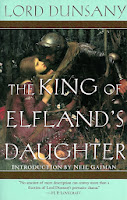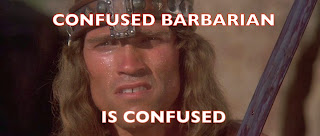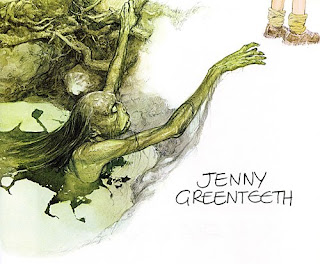As promised in my last entry, here's my test-drive of one of the
Beyond the Wall Character Playbooks. The game comes with six playbooks, two for each of the game's three classes: the Warrior is represented by the Village Hero and the Would-Be Knight; the Rogue, by the Untested Thief and the Young Woodsman; and the Mage, by the Self-Taught Mage and the Witch's Prentice. (There are other playbooks devoted to noble characters and demi-humans in layout right now.) To keep things simple, I'm going to start with one of the Warrior playbooks, the Village Hero. It's not exactly an Assistant Pig-Keeper, but it's as close as
BTW currently gets to that archetype.
The Village Hero begins the character creation process with scores of 10 in STR and CON and scores of 8 in the remaining four abilities. These scores will change in response to my rolls on seven background tables, three detailing the character's childhood and four explaining how the character became a member of his or her class.
To discover what my character's parents did for a living, I roll 1d12 and consult the first table. A roll of 10 reveals that my father was a watchman, "stern but fair with child and stranger alike." In game terms, I increase the character's STR to 12, his CON to 11, and his CHA to 9. I also add the Athletics skill; in
BTW, skills add +2 to relevant ability checks.
Attached to this table is an icon depicting a scroll. This icon tells me that I may now add a location to the village map and thus determine a fact about the characters' home town. (
BTW's village map begins with a tavern icon in the center and then encourages the group to create the rest of the village as they move through the character creation process.) I don't
have to link this location to my roll on the table, but I'll do so nonetheless, placing a town jail next to the tavern.
The second table asks me to roll 1d8 to learn what distinguished my hero as a child. My roll of 8 reveals that the character was fairly well-rounded as a lad, learning a bit of something from everyone. His DEX, INT, and WIS all increase to 9.
The third and final childhood table uses a 1d8 roll to determine which of the villagers befriended my character in his youth. (
BTW assumes that the player characters were all best friends growing up, so this table is used to establish who else was particularly friendly.) I get another result of 8: "The grizzled mercenary who settled in town taught you a thing or two." I raise my hero's DEX and WIS to 10 and boost his CON to 12.
I also find another icon linked to the table, this time an image of a hand. The rules inform me that I may add an NPC to the list of villagers on the right side of the village map. Again I'll play things straight and make this NPC my character's mercenary mentor.
Three rolls into the process, I now have a warrior character with STR 12, DEX 10, CON 12, INT 9, WIS 10, and CHA 9. He also has the Athletics skill. Finally, I've made two explicit contributions to the party's home base: the town jail and a retired soldier. Perhaps the latter is my hero's father's deputy—or perhaps the mercenary was an amiable drunk who spend lots of time detoxing in the jail and thus got to know my character. There are lots of possibilities here.
I now move to the tables explaining how my character became a Level 1 Warrior. As a beginning Warrior, I acquire two class abilities: Weapon Specialization and Knacks. (The playbook instructs me that my rolls will determine the exact nature of these abilities.) I also pick up the Folklore skill.
Table Four asks me to roll 1d6 to determine how my hero made his name as a fighter. I get a 4 and discover that I saved one of the village children from a pack of ravenous wolves. A bonus of +3 increases my DEX to 13; I also acquire the Survival skill.
Next I roll 1d6 to establish where my character acquired his facility with arms. My result of 1 indicates that I stood in the shield wall during an enemy attack on the village, giving me +2 to CON (for a total of 14) and a Weapon Specialization with the Spear. There's a scroll icon linked to this table, giving me an opportunity to create another village location. Again I opt for the obvious choice and place a crumbling stone wall around the outside of the map.
The sixth table is one of the more interesting ones. It determines my hero's secret, but it also establishes that the hero of the player to my right shares this secret. I roll 1d6 and get a result of 2: apparently my hero once ran from danger—and so did my character's compatriot. My hero raises his DEX to 15 and gains the Fleet Knack; the other player's hero raises his character's DEX by 1.
The seventh and last table is used to determine one of my hero's key possessions. This table varies from playbook to playbook and class to class; in the Village Hero's case, it determines the character's reward for bravery from his fellow villagers. My roll of 3 indicates that the blacksmith made my character a "well-crafted" weapon; I raise my hero's STR to 14 and add a "very fine" spear to his inventory. Cued by the hand icon attached to the table, I also add the blacksmith to the list of villagers.
My hero is now ready for play. Here's his sheet:
STR 14 (+1 to hit and to damage in HTH combat)
DEX 15 (+1 to hit in ranged combat and +1 to AC)
CON 14 (+1 HP per level)
INT 9
WIS 10
CHA 9
Skills: Athletics, Folklore, Survival
Class Abilities: Weapon Specialization with Spear (+1 to hit and +2 to damage with this weapon), Fleet Knack (+1 to initiative)
Equipment: knife (d4 base damage), peasant's clothing, finely made spear (d6 base damage), thickest shield in town (+2 AC), leathers (+2 AC), free food and lodging forever, and 9 silver pieces
Alignment: Lawful
Base Attack Bonus: +1 (when wielding his spear, my hero has a total hit bonus of +3 and a damage roll of 1d6+3)
Initiative: +3
AC: 15
Fortune Points: 3
HP: 11
Saving Throws: Poison 14, Breath Weapon 17, Polymorph 15, Spell 17, Magic Item 16












































